Recessionary Inflationary
Recessionary Gap (Contractionary Gap)
It is situation where the country’s real GDP is lower than its potential GDP at the full employment level. Here, the economy is not operating at the full employment equilibrium. The gap occurs between the actual output and the potential output; in this condition actual output is lower than the potential output. This is also known as recessionary gap.
Contractionary gap occurs when an economy is approaching a slow down or a recession or any business cycle contraction. It happens between a short-run equilibrium level and long-run full employment equilibrium. The potential GDP outweighs the real GDP because the aggregate output of the economy lower than the aggregate output that would be produced at full employment level.
Full employment is a condition where the economy utilizes all its resources to its potential and the unemployment rate is at its natural level which means number of people unemployed in the economy I equal to the number of jobs available. These people are unemployed because of structural, frictional etc. reasons. Thus, in a contractionary gap situation, the unemployment rate is greater than the natural rate of unemployment.
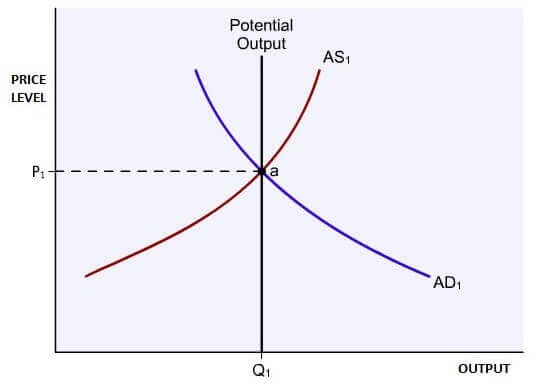
Suppose the economy is operating at point-a where the aggregate demand and aggregate supply curve intersect. And Q1 is the potential output of the economy i.e. full employment level.
A contractionary gap happens when an economy is falling into a recession and this can happen if there is a higher nominal exchange rate, which reduces net exports and domestic income leading to a large reduction in consumer expenditure or investment due to a decrease in wages of workers. When the economy operates below the full-employment level, it pushes the general price level down in the long-term.
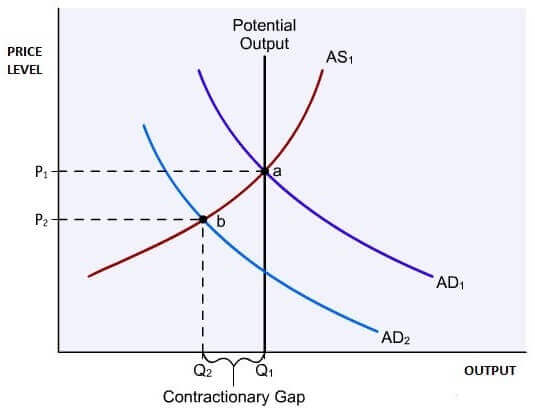
From the figure, as the aggregate demand decreases due to contraction, it shifts left from AD1 to AD2. And now the new equilibrium is established at point-b with Q2 level of output which is less than the Q1. However, in contractionary gap, the price level too decreases. This is also called as below full employment equilibrium i.e. the intersection of aggregate demand and aggregate supply curves lies to the left of the full employment equilibrium condition. The size of the contractionary gap can be known from the difference between actual and potential output i.e. Potential Output - Actual Output = Contractionary Gap.
The main reason for this gap is the inefficient resource allocation that causes price are sticky in the short-term and wages tend to be inefficiently allocated, thus causing a slowdown in the economy as firms have lower profits and are forced to lay off more workers which thus increase the unemployment rate.
Economic Policies to Restore Potential Output with Recessionary Gap
Firstly, leave the market forces to work and adjust with time. In the long run, real wages adjusts to the equilibrium level, employment move back to its natural level, and real GDP reaches the potential level. This is called as non-intervention policy. Secondly, as the above policy will take time, thus, government and policy makers can undertake policies to shift the aggregate demand or short-run aggregate supply curves in a way that moves the economy to its potential. This is called as stabilization policy.
To fight this recessionary gap, governments impose an expansionary fiscal policy like increase in government purchases or lowering taxes which will shift the aggregate demand curve back to its initial level from AD2 to AD1. And the economy is back to its potential output. This is the stabilization policy.
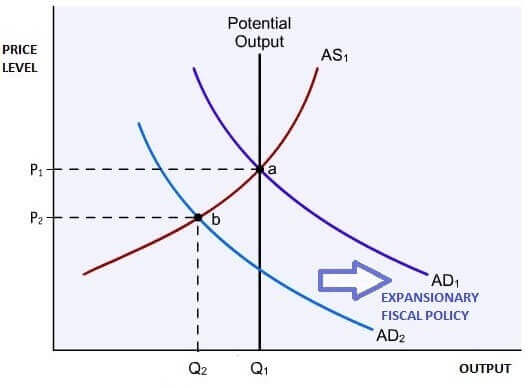
Also, this recessionary gap can be treated with fall in nominal wages over time. However, this will shift the aggregate supply curve to the right from AS1 to AS2. This will lead to fall in the price level too. This process happens with time because nominal wages are sticky, but gradually the short-run aggregate supply curve moves and potential output is reached. This is the non-intervention policy.
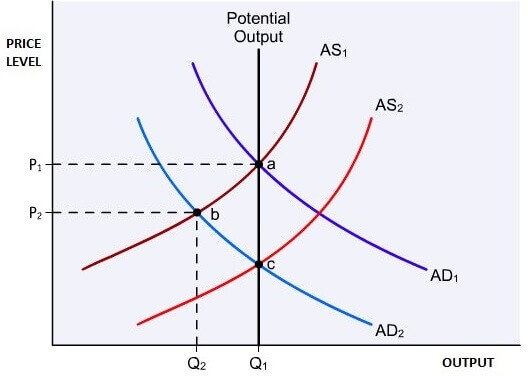
Want to master the Macroeconomics of Expansionary Monetary Policy and Expansionary Fiscal Policy? Get the best homework help and Assignment Help for Macroeconomics theories and policies from Assignmenthelp.net
Inflationary Gap (Expansionary Gap)
It is situation where the country’s real GDP is higher than its potential GDP at the full employment level. Here, the economy is not operating at the full employment equilibrium. The gap occurs between the actual output and the potential output; in this condition actual output is higher than the potential output. This is also known as inflationary gap. It is so named because a rise in the level of an economy's GDP will cause an increase in consumption which leads to higher prices. Expansionary gap is the opposite of contractionary gap.
It occurs in case of business cycle expansion in the short run, due to which, the output in the short run is more than its full employment level which means more people are employed than the full employment level i.e. economy is utilizing more labour than full employment implying labour shortage. This puts pressure on the wages and prices ultimately rise.
This is also called as above full-employment equilibrium because the economy is producing goods at a higher level then it usually does. However, there will not be any excess supply in the short run but this overly will create more demand for goods and services, which will increase the prices i.e. inflation increases.
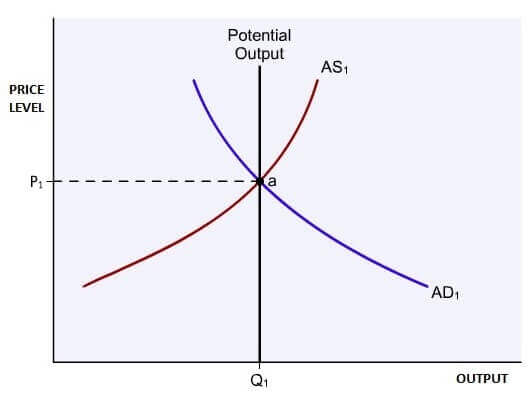
From the figure above, due to business expansion, the demand for goods and services increases which leads to shift in the AD curve and thus the output level too rises from Q1 to Q2 and the prices rise from P1 to P2 and this causes inflation in the economy. The new equilibrium point is b. Here, the output is above potential output. And employment is more than its natural level.
The size of the expansionary gap can be calculated by the difference of actual output and potential output i.e. Actual Output- Potential Output= Expansionary Gap.
Economic Policies to Restore the Potential Output from Expansionary Gap
As the earlier case too, here there are two types of policy i.e. non-intervention policy and stabilization policy.
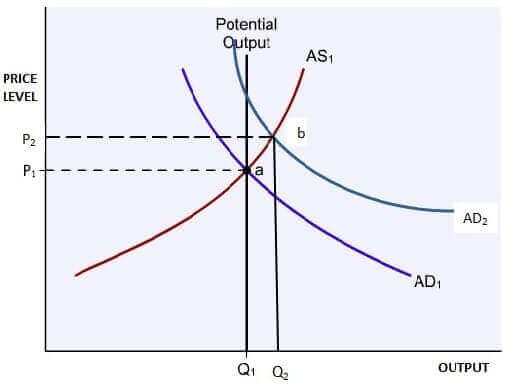
Suppose the economy is in equilibrium at point-a, where the output is at its potential output. Now, if there is an increase in government purchases, there will be an increase in the aggregate demand from AD1 to AD2 which results in n price increase i.e. inflationary gap and also, the output moves above the potential output. This higher price level will lead to a lower real wage because nominal wage is fixed. Thus, firms will employ more workers to supply the increased output. Here, the expansionary gap is Q2-Q1.
Workers will realize that they are worse off, and demand higher nominal wage to restore their purchasing power. This will increase the cost of production for firms, and the aggregate supply curve will shift left and firms will lay off extra workers.
This will continue till the gap. Thus, the new aggregate supply curve is AS2. Economy is back to its potential output but at a higher price level. This is the non-intervention policy as the economy adjusts accordingly to the shift in AD.
Also, government takes up the stabilization policy through the contractionary fiscal policy. This will reduce the output and economy will return to the full employment level.
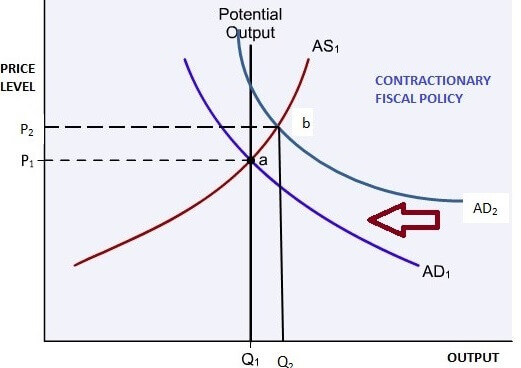
Here, after the aggregate demand had increased, the economy was at point-b but government takes up a contractionary fiscal policy which done by increasing taxes or reducing government purchases. Then again, the aggregate demand curve shifts back to it earlier level AD1 and establishes equilibrium at point-a and output is at its potential level.
For both recessionary gap and inflationary gap, a combination of non-interventionist policy which lets market forces in the economy close part of the gap and also using stabilization policy to close the rest of the gap is also an option.
Want to master the Macroeconomics of Contractionary Monetary Policy and Contractionary Fiscal Policy? Get the best help with Macroeconomics homework, assignments, assessments and projects from Assignmenthelp.net



